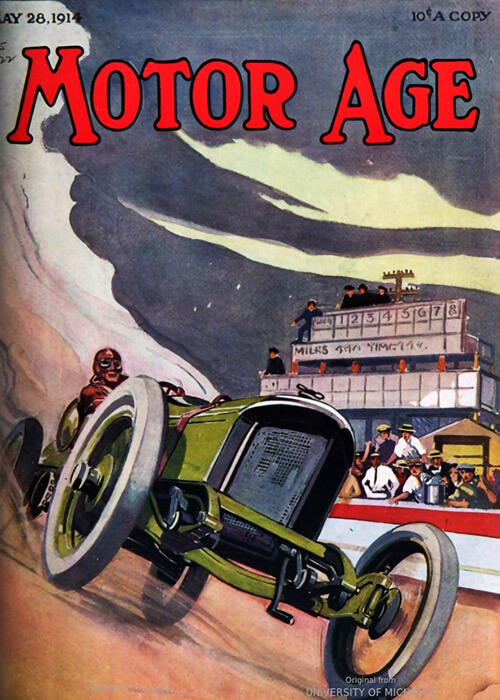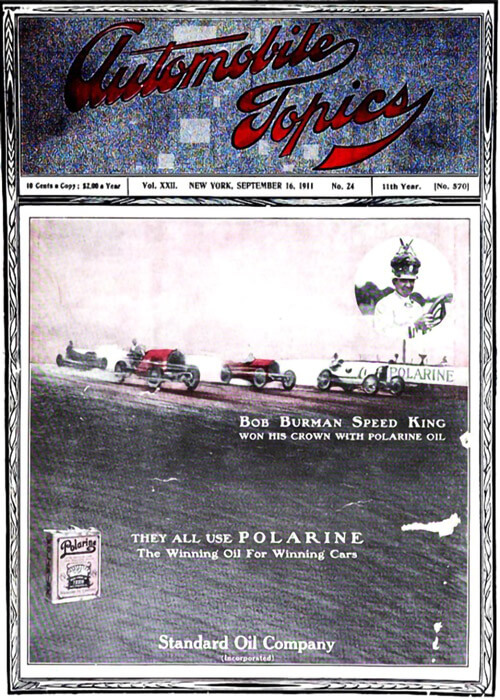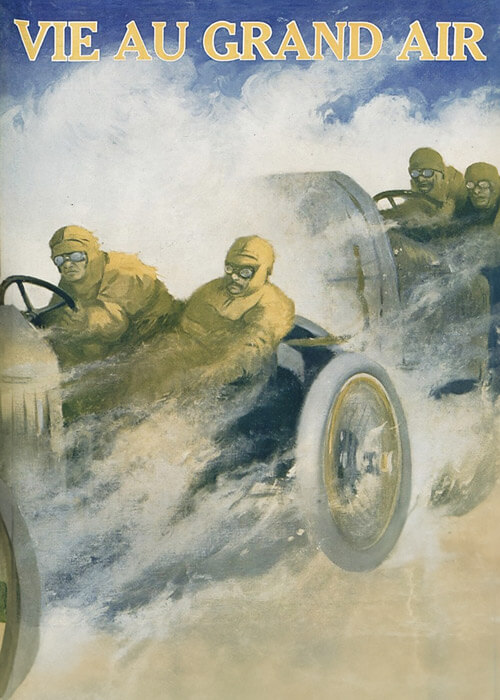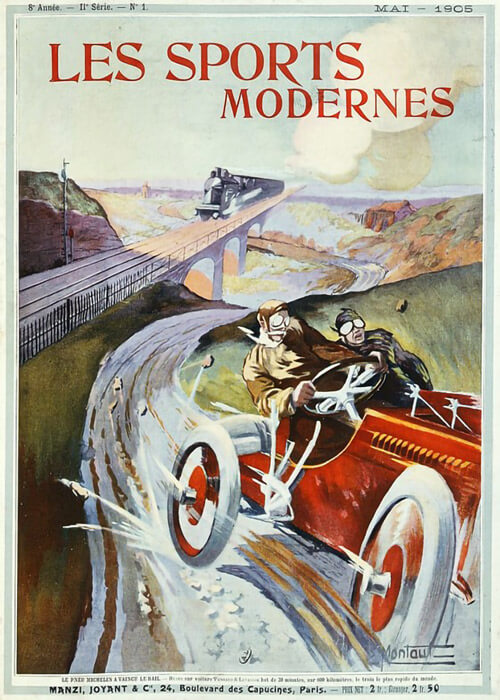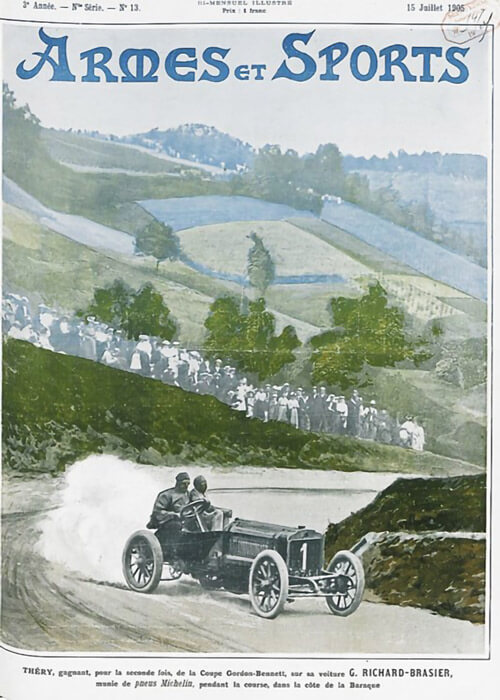The French magazine „La Vie Automobile“ was very much assigned to technical descriptions of cars and engines in particular. But they also reported the 1905 Vanderbilt Cup race; now in two separate articles. This first one, of October that year, mistakenly mentions that the cup race was held on Florida.
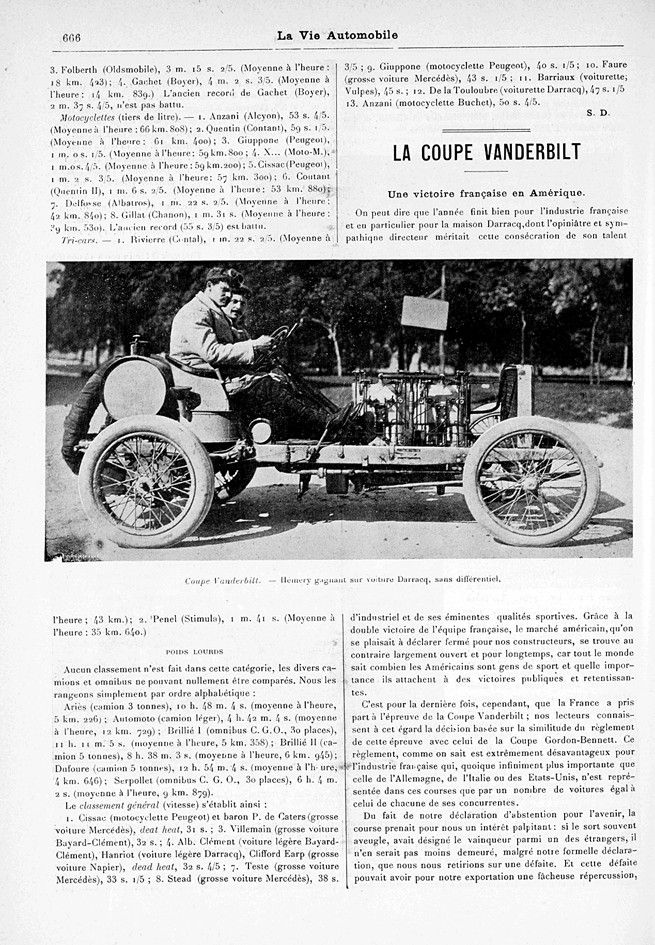
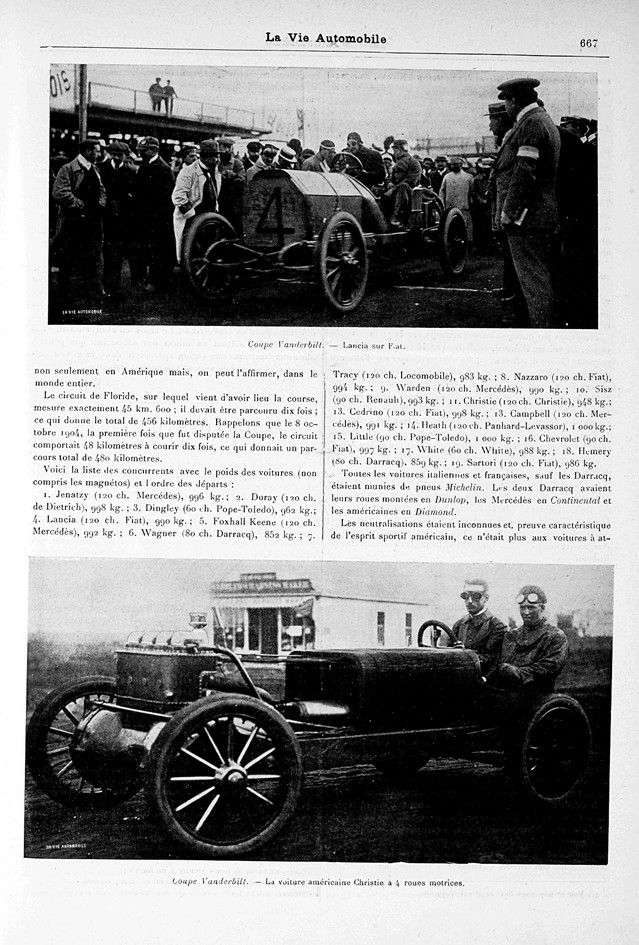
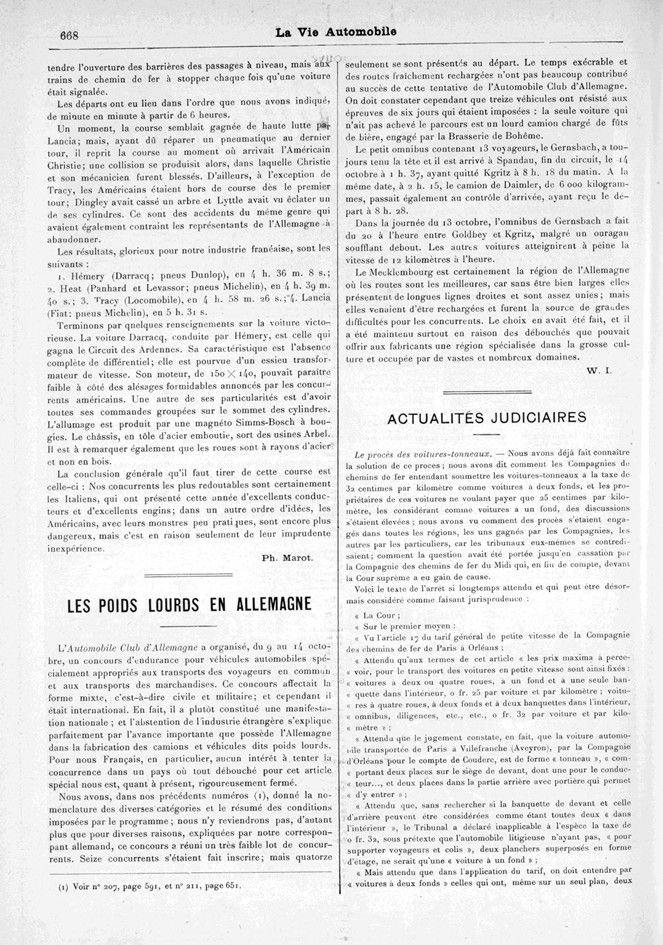
Texte et images jpg avec l’autorisation de gallica.bnf.fr / / Bibliothèque national français, compilé par motorracinghistory.com,
La Vie Automobile – 5e Année, Vol. 5 – No. 212 – Samedi, 21 Octobre 1905
LA COUPE VANDERBILT
Une victoire française en Amérique.
On peut dire que l’année finit bien pour l’industrie française et en particulier pour la maison Darracq, dont l’opiniâtre et sympathique directeur méritait cette consécration de son talent d’industriel et de ses éminentes qualités sportives. Grâce à la double victoire de l’équipe française, le marché américain, qu’on se plaisait à déclarer fermé pour nos constructeurs, se trouve au contraire largement ouvert et pour longtemps, car tout le monde sait combien les Américains sont gens de sport et quelle importance ils attachent à des victoires publiques et retentissantes.
C’est pour la dernière fois, cependant, que la France a pris part à l’épreuve de la Coupe Vanderbilt ; nos lecteurs connaissent à cet égard la décision basée sur la similitude du règlement de cette épreuve avec celui de la Coupe Gordon-Bennett. Ce règlement, comme on sait est extrêmement désavantageux pour l’industrie française qui, quoiqu’infiniment plus importante que celle de l’Allemagne, de l’Italie ou des Etats-Unis, n’est représentée dans ces courses que par un nombre de voitures égal à celui de chacune de ses concurrentes.
Du fait de notre déclaration d’abstention pour l’avenir, la course prenait pour nous un intérêt palpitant : si le sort souvent aveugle, avait désigné le vainqueur parmi un des étrangers, il n’en serait pas moins demeuré, malgré notre formelle déclaration, que nous nous retirions sur une défaite. Et cette défaite pouvait avoir pour notre exportation une fâcheuse répercussion, non seulement en Amérique mais, on peut l’affirmer, dans le monde entier.
Le circuit de Floride, sur lequel vient d’avoir lieu la course, mesure exactement 45 km. 600 ; il devait être parcouru dix fois ; ce qui donne le total de 456 kilomètres. Rappelons que le 8 octobre 1904, la première fois que fut disputée la Coupe, le circuit comportait 48 kilomètres à courir dix fois, ce qui donnait un parcours total de 48o kilomètres.
Voici la liste des concurrents avec le poids des voitures (non compris les magnétos) et l’ordre des départs :
1. Jenatzy (120 ch. Mercédès), 996 kg.; 2. Duray (120 ch. de Dietrich), 998 kg. ; 3. Dingley (60 ch. Pope-Toledo), 962 kg.; 4. Lancia (120 ch. Fiat), 990 kg.; 5. Foxhall Keene (120 ch. Mercédès), 992 kg. ; 6. Wagner (80 ch. Darracq), 852 kg. ; 7. Tracy (120 ch. Locomobile), 983 kg. ; 8. Nazzaro (120 ch. Fiat), 994 kg.; 9. Warden (120 ch. Mercédès), 990 kg.; 10. Sisz (90 ch. Renault), 993 kg. ; 11. Christie (120 ch. Christie), 948 kg.; t3. Cedrino (120 ch. Fiat), 998 kg. ; 13. Campbell (120 ch. Mercédès), 991 kg. ; 14. Heath (120ch. Panhard-Levassor), 1 000 kg.; 15. Little (90 ch. Pope-Toledo), 1 000 kg. ; 16. Chevrolet (90 ch. Fiat), 997 kg. ; 17. White (60 ch. White), 988 kg. ; 18. Hemery (8o ch. Darracq), 859 kg. ; 19. Sartori (120 ch. Fiat), 986 kg.
Toutes les voitures italiennes et françaises, sauf les Darracq, étaient munies de pneus Michelin. Les deux Darracq avaient leurs roues montées en Dunlop, les Mercédès en Continental et les Américaines en Diamond.
Les neutralisations étaient inconnues et, preuve caractéristique de l’esprit sportif américain, ce n’était plus aux voitures à attendre l’ouverture des barrières des passages à niveau, mais aux‘ trains de chemin de fer à stopper chaque fois qu’une voiture était signalée.
Les départs ont eu lieu dans l’ordre que nous avons indiqué, de minute en minute à partir de 6 heures.
Un moment, la course semblait gagnée de haute lutte par Lancia; mais, ayant dû réparer un pneumatique au dernier tour, il reprit la course au moment où arrivait l’Américain Christie; une collision se produisit alors, dans laquelle Christie et son mécanicien furent blessés. D’ailleurs, à l’exception de Tracy, les Américains étaient hors de course dès le premier tour ; Dingley avait cassé un arbre et Lyttle avait vu éclater un de ses cylindres. Ce sont des accidents du même genre qui avaient également contraint les représentants de l’Allemagne à abandonner.
Les résultats, glorieux pour notre industrie française, sont les suivants :
1. Hémery (Darracq ; pneus Dunlop), en 4 h. 36 m. 8 s. ; 2. Heat (Panhard et Levassor ; pneus Michelin), en 4 h. 39 m. 40 s. ; 3. Tracy (Locomobile), en 4 h. 58 m. 26 s. 4. Lancia (Fiat : pneus Michelin), en 5 h. 31 s.
Terminons par quelques renseignements sur la voiture victorieuse. La voiture Darracq, conduite par Hémery, est celle qui gagna le Circuit des Ardennes. Sa caractéristique est l’absence complète de différentiel ; elle est pourvue d’un essieu transformateur de vitesse. Son moteur, de 150X140, pouvait paraître faible à côté des alésages formidables annoncés par les concurrents américains. Une autre de ses particularités est d’avoir toutes ses commandes groupées sur le sommet des cylindres. L’allumage est produit par une magnéto Simms-Bosch à bougies. Le châssis, en tôle d’acier emboutie, sort des usines Arbel.
Il est à remarquer également que les roues sont à rayons d’acier et non en bois.
La conclusion générale qu’il faut tirer de cette course est celle-ci : Nos concurrents les plus redoutables sont certainement les Italiens, qui ont présenté cette année d’excellents conducteurs et d’excellents engins; dans un autre ordre d’idées, les Américains, avec leurs monstres peu pratiques, sont encore plus dangereux, mais c’est en raison seulement de leur imprudente inexpérience.
Ph. Marot.
Photos.
Coupe Vanderbilt. — Hémery gagnant sur voiture Darracq, sans différentiel.
Lancia sur Fiat.
Coupe Vanderbilt. — La voiture américaine Christie à 4 roues motrices.
Translation by DeepL.com
THE VANDERBILT CUP – A French victory in America.
It can be said that the year ends well for French industry and in particular for the Darracq company, whose stubborn and friendly director deserved this recognition of his industrial talent and his outstanding sporting qualities. Thanks to the French team’s double victory, the American market, which we liked to claim was closed to our manufacturers, is on the contrary wide open and will remain so for a long time, because everyone knows how sporty Americans are and how much importance they attach to public and resounding victories.
However, this is the last time that France has taken part in the Vanderbilt Cup event; our readers will be aware of the decision based on the similarity of the rules of this event with those of the Gordon Bennett Cup. These rules, as we know, are extremely disadvantageous for French industry which, although infinitely more important than that of Germany, Italy or the United States, is only represented in these races by a number of cars equal to that of each of its competitors.
Because of our declaration of abstention for the future, the race took on an exciting interest for us: if fate, often blind, had chosen the winner from among the foreigners, it would nevertheless remain, despite our formal declaration, that we were withdrawing after a defeat. And this defeat could have unfortunate repercussions for our export, not only in America but, it can be said, throughout the whole world.
The Florida circuit, on which the race has just taken place, measures exactly 45 km 600; it had to be covered ten times, which gives a total of 456 kilometers. On October 8, 1904, the first time the Cup was held, the circuit was 48 kilometers long, to be run ten times, giving a total distance of 480 kilometers.
Here is the list of competitors with the weight of the cars (not including the magnetos) and the starting order:
1. Jenatzy (120 hp Mercedes), 996 kg; 2. Duray (120 hp De Dietrich), 998 kg; 3. Dingley (60 hp Pope-Toledo), 962 kg; 4. Lancia (120 hp Fiat), 990 kg; 5. Foxhall Keene (120 hp Mercedes), 992 kg; 6. Wagner (80 hp Darracq), 852 kg; 7. Tracy (120 hp Locomobile), 983 kg; 8. Nazzaro (120 hp Fiat), 994 kg; 9. Warden (120 hp Mercedes), 990 kg; 10. Sisz (90 hp Renault), 993 kg; 11. Christie (120 hp Christie), 948 kg; t3. Cedrino (120 hp Fiat), 998 kg; 13. Campbell (120 hp Mercedes), 991 kg; 14. Heath (120 hp Panhard-Levassor), 1,000 kg; 15. Little (90 hp Pope-Toledo), 1,000 kg; 16. Chevrolet (90 hp Fiat), 997 kg; 17. White (60 hp White), 988 kg; 18. Hemery (80 hp Darracq), 859 kg; 19. Sartori (120 hp Fiat), 986 kg.
All the Italian and French cars, except the Darracqs, were fitted with Michelin tires. The two Darracqs had Dunlop tires, the Mercedes had Continental tires and the American cars had Diamond tires.
Neutralization was unheard of and, in a characteristic display of American sportsmanship, it was no longer up to the cars to wait for the level crossing gates to open, but up to the railroad trains to be stopped every time a car was signaled.
The races started in the order indicated, every minute from 6 o’clock.
At one point, it looked like Lancia had won the race in a tight contest; but, having had to repair a tire on the last lap, he resumed the race just as the American Christie was arriving; a collision then occurred, in which Christie and his mechanic were injured. Moreover, with the exception of Tracy, the Americans were out of the race from the first lap; Dingley had broken a shaft and Lyttle had seen one of his cylinders burst. It was accidents of the same kind that had also forced the German representatives to give up.
The results, glorious for our French industry, are as follows:
1. Hémery (Darracq; Dunlop tires), in 4 h. 36 m. 8 s.; 2. Heat (Panhard et Levassor; Michelin tires), in 4 h. 39 m. 40 s.; 3. Tracy (Locomobile), in 4 h. 58 m. 26 s.; 4. Lancia (Fiat: Michelin tires), in 5 h. 31 s.
Let’s finish with some information about the winning car. The Darracq car, driven by Hémery, was the winner of the Circuit des Ardennes. Its distinguishing feature is the complete absence of a differential; it is equipped with a speed-changing axle. Its 150X140 engine might have seemed weak compared to the formidable bore sizes announced by the American competitors. Another of its special features is that all its controls are grouped together at the top of the cylinders. The ignition is produced by a Simms-Bosch magneto with spark plugs. The chassis, made of pressed steel, comes from the Arbel factories.
It is also worth noting that the wheels have steel spokes and not wooden ones.
The general conclusion to be drawn from this race is this: Our most formidable competitors are certainly the Italians, who this year presented excellent drivers and excellent machines; on another note, the Americans, with their impractical monsters, are even more dangerous, but this is only due to their reckless inexperience.
Ph. Marot.
Photos.
Vanderbilt Cup. — Hémery wins in a Darracq car without a differential.
Lancia on Fiat.
Vanderbilt Cup. — The American Christie car with 4-wheel drive.
